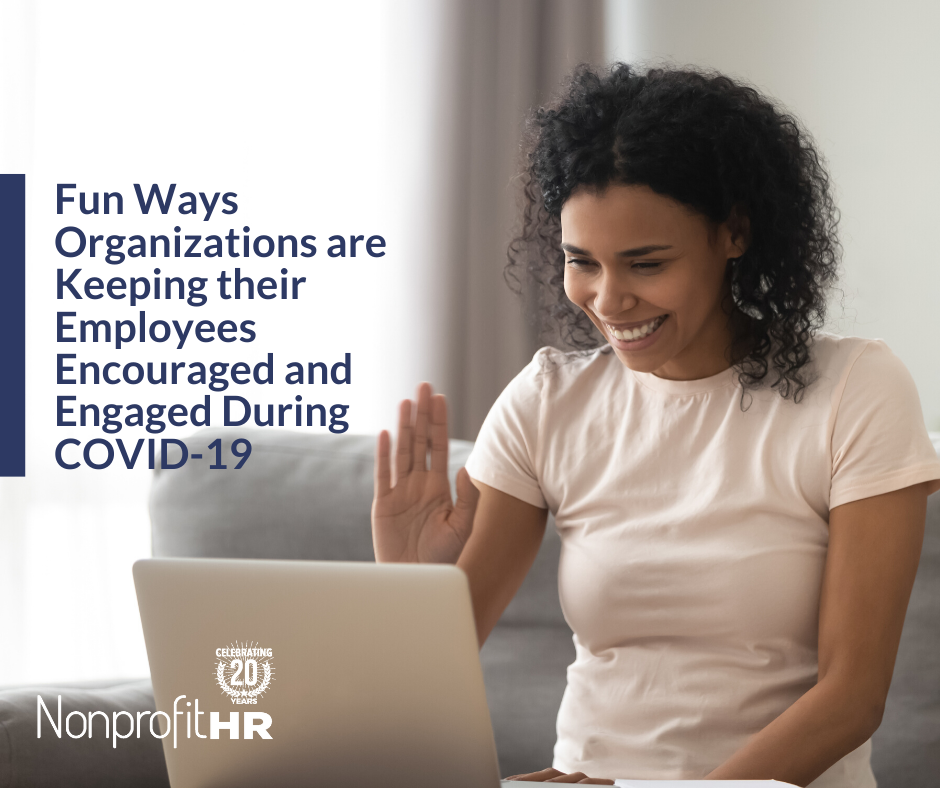WTOP: 5 ways nonprofits can…
The good news: most nonprofits have a strategic plan, which serves as a roadmap for advancing and achieving the organization’s mission. The bad news: many nonprofits don’t align their organizational strategy with their human resources strategy.
The YMCA of the USA models this alignment really well. The organization has done an incredible job of aligning their HR strategies with their strategic plan, and in doing so, they’ve improved their overall culture and positioned their HR team as a strategic business partner to the leadership team.
Why is this so important? Attracting, retaining and developing talent are not just operational tasks. These activities provide immense value to your organization. It’s only through investing in talent and fully leveraging your staff’s capabilities that you’ll be able to achieve your mission.
If you currently have a strategic plan but are unsure how to align it with your talent and culture strategies, we have six steps to set you up for success, as well as examples that explain how YMCA has put these concepts into action. So round up the members of your leadership team and get a copy of your organization’s strategic plan in hand. This step-by-step process will get you moving in the right direction.
-
Have a clear understanding of your organizational strategy.
In most cases, a nonprofit’s board of directors is in charge of creating the strategic plan. Before diving into the nuts and bolts of talent, development, engagement and culture, your leadership team—and everyone involved with your organization’s talent and culture practices—has to understand the strategic goals that have been set. What do you want to accomplish in the next one, two, three years? How do these goals relate to your overall mission? With your mission and your end goals in sight, you’ll be better equipped to put the right people in place—people who will contribute, collaborate and innovate in exactly the right way to meet objectives and advance your mission.
Jackie Gordon, Senior Vice President of HR at YMCA of the USA, says that having her organization’s HR strategy integrated with its strategic plan has made a world of a difference.
“We’ve been able to readjust our workforce based on our strategic goals and either hire or train current staff with the skillsets that will allow them to reach their goals with plenty of notice,” Gordon explains.
-
Build leadership and talent models.
As a second step, you will want to define the types of talent you need and get clear on what you expect from each role. Your leadership and your staff members must have the expertise, competencies and skills needed to meet your strategic objectives. Start with your goals and identify the talent you need to realize each one. Then assess if you already have the talent that you need or if you need to develop a plan for attracting and hiring new people into the organization. You may also need to modify or clarify your expectations for existing roles. This process can be organic and informal, or more intentional and structured like YMCA’s.
“YMCA of the USA has a leadership development department that builds competency models for the organization’s various types of roles,” Gordon explains. “These models show employees what they need to do to be successful in their current roles and provide a concrete list of skills they need to acquire to progress in their careers.”
After these models are developed, managing with them in mind is key. Research from Ernst & Young shows that high-performing companies tend to manage talent and set expectations more effectively than lower-performing companies. Not sure where to start? If you have a senior-level HR leader with talent management experience within your organization, this person can take the lead. If not, consider bringing in a strategic partner like Nonprofit HR to provide this expertise.
-
Pinpoint sources for identifying the right talent.
Once you know what specific talent you need to support organizational objectives, you’ll have to figure out where to find the right people to fulfill those needs. As mentioned before, those people may already be working within your organization. How will you determine who’s best suited for a specific role?
In other cases, you might have to look outside of your organization for the expertise and experience needed to carry out your strategic plan. When Gordon’s team hires, they often look to bring in talent that comes not just from outside of the YMCA network, but also from outside of the nonprofit sector itself. This allows the organization to recruit more diverse employees with the unique skillsets required to realize key objectives in their strategic plan.
Where will you go to find and attract the right types of new talent? Tap into the channels jobseekers are using to find jobs: online job boards, social and professional networks, word of mouth, company websites and professional groups. Whether you plan to reach out to key contacts in your network or connect with candidates via networking events, college career fairs or social media, narrowing in on which sources you’ll utilize based on proven insights about where your target employees are spending their time, will help streamline your talent acquisition strategy.
-
Create a process for developing talent.
There’s a good chance you already have the talent you need. Your team members might just require some additional training, professional development or mentoring to grow into a new role or take on expanded responsibilities. What tools and resources do they need? How will you make sure they receive them?
You might also consider going through the process of identifying those individuals within your organization who are “high performing.” According to consulting firm, Bersin by Deloitte, a “high performer” is an employee who is a key contributor, demonstrates high performance, is capable of a lateral move, may be qualified for a broader role within the same profession and has reached the potential to move “upward’ in a management capacity. By giving high performers new and challenging opportunities, you increase the likelihood of keeping them engaged and ultimately retaining them. Having a plan of action for developing and attracting high performers is a key part of any effective talent management strategy.
It’s important to note that simply hiring the right talent doesn’t mean they will have the support to grow to their full potential. Developing talent is an absolute must for ensuring their success—and your nonprofit’s.
“At YMCA of the USA, we provide training to those who have the capacity to take on the new projects or responsibilities,” Gordon explains. “While we see value in hiring from outside of the sector for certain roles, we also are highly devoted to cultivating our talent from within and helping our most promising team members to grow.”
-
Engage staff members.
A Gallup study found that only 13 percent of employees worldwide are engaged in their work. If your staff is a part of that 13 percent, they likely have a sense of belonging and feel that they’re contributing to the bigger picture. To fully engage talent, tap into their unique interests and capabilities, provide new challenges and opportunities and be sure it’s clear how their contributions have an impact on your mission. A feeling of purpose will ignite passion and boost productivity. The bottom line: engaged employees move your organization forward.
Gordon has found that getting serious about engagement has significant returns. In fact, since putting an employee engagement strategy in place, employee satisfaction ratings have grown to 92 percent at YMCA of the USA.
“For us, engagement extends far beyond saying ‘we hear your frustrations and we’ll provide a solution,’” Gordon said. “It involves the creation of initiatives, programs and opportunities that improve the quality of work employees are doing and the satisfaction they get from that work.”
-
Cultivate a workplace culture that is conducive to your goals and reflective of your values.
Effective talent management is about more than the individuals who make up your team; it also encompasses your organization’s culture and values. Although culture is often viewed as important, it’s not always easily understood. But not actively managing it can have major repercussions: According to Deloitte’s 2016 Global Human Capital Trends report, culture has a significant effect on whether an organization experiences success or failure during times of change and growth.
Your workplace environment needs to be one that allows and encourages the type of work that’s needed to meet strategic goals. If creativity and innovation are important to advancing your mission, your culture needs to be one that celebrates new ideas and is forgiving of missteps along the way. If collaboration and communication are necessary, an environment that fosters teamwork and open conversation is key to being successful.
“We measure what is and is not working about our culture regularly, and frequently initiate new programs to cultivate a positive work environment,” Gordon says. “But those new programs have to be in line with our strategic goals,” she adds. “That’s a great lens through which to make decisions.”
As Jackie Gordon and her team at YMCA of the USA have proven, it’s crucial to invest in aligning your talent and culture strategy with your overall strategy if you want to attract, retain and develop talent capable of helping your organization make progress. Neglecting your people strategy will slow down and negatively impact your progress toward your mission. Know who you need and where to find them, create opportunities for continuous learning and development, proactively foster healthy workplace culture, and engage staff in developing new and effective ways to get the work done.
Creating a strategic plan is a great first step. But remember that people carry out that strategic plan. Your talent is your greatest resource and your strongest asset in working toward—and meeting—your nonprofit’s goals and objectives. To put it plainly, people make things happen. People further your mission.





























